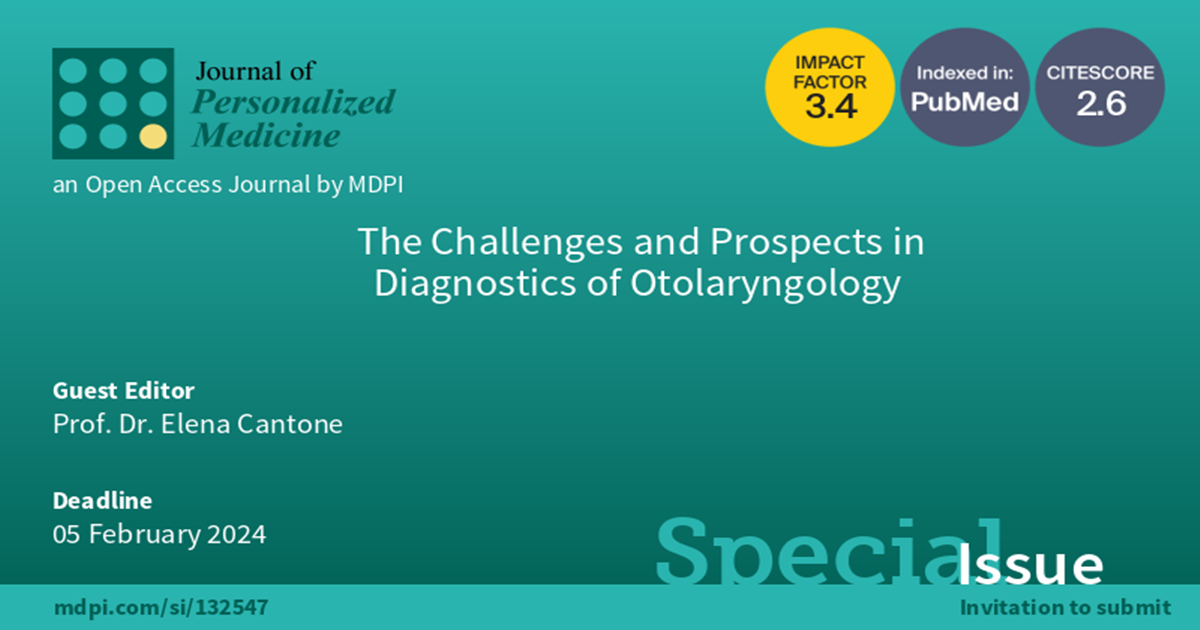The Challenges and Prospects in Diagnostics of Otolaryngology
A special issue of Journal of Personalized Medicine (ISSN 2075-4426). This special issue belongs to the section "Methodology, Drug and Device Discovery".
Deadline for manuscript submissions: closed (5 February 2024) | Viewed by 5323

Special Issue Editor
Interests: laryngology; rhinology; biologics; head and neck oncology; chemical sense; neuroimaging; pediatric otorhinolaryngology; head and neck surgery; otorhinolaryngology; personalized medicine
Special Issues, Collections and Topics in MDPI journals
Special Issue Information
Dear Colleagues,
In the last decade, precision medicine has revolutionized clinical practice and, in particular, otorhinolaryngology.
Every day we are faced with new diagnostic challenges that require a meticulous and often multidisciplinary diagnostic process.
The purpose of this Special Issue is to offer readers and colleagues several new diagnostic tools in the otorhinolaryngologic fields and beyond.
For instance, with the perspective of precision medicine and a multidisciplinary approach, this Special Issue aims to describe not only the new challenges in otorhinolaryngological diagnostics but also to provide useful tools in clinical practice to personalize therapeutic strategies with a view to patient customization.
Furthermore, the need for an integrated multidisciplinary approach in the evaluation of pathologies in the rhinological, otological, and laryngological fields cannot be overlooked.
These are the reasons why I proposed this Special Issue of the Journal of Personalized Medicine, to collect papers about “The Challenges and Prospects in Diagnostics of Otolaryngology” in all of the fields of otorhinolaryngology as well as in related fields. Studies should describe challenges and prospects in the diagnostics of otorhinolaryngology using basic-science-, clinical-, and population-based approaches.
Prof. Dr. Elena Cantone
Guest Editor
Manuscript Submission Information
Manuscripts should be submitted online at www.mdpi.com by registering and logging in to this website. Once you are registered, click here to go to the submission form. Manuscripts can be submitted until the deadline. All submissions that pass pre-check are peer-reviewed. Accepted papers will be published continuously in the journal (as soon as accepted) and will be listed together on the special issue website. Research articles, review articles as well as short communications are invited. For planned papers, a title and short abstract (about 100 words) can be sent to the Editorial Office for announcement on this website.
Submitted manuscripts should not have been published previously, nor be under consideration for publication elsewhere (except conference proceedings papers). All manuscripts are thoroughly refereed through a single-blind peer-review process. A guide for authors and other relevant information for submission of manuscripts is available on the Instructions for Authors page. Journal of Personalized Medicine is an international peer-reviewed open access monthly journal published by MDPI.
Please visit the Instructions for Authors page before submitting a manuscript. The Article Processing Charge (APC) for publication in this open access journal is 2600 CHF (Swiss Francs). Submitted papers should be well formatted and use good English. Authors may use MDPI's English editing service prior to publication or during author revisions.
Keywords
- head and neck oncology
- rhinology
- otology
- laryngology
- lmmunology
- biomarkers
- OSAS
- EGPA
- diagnosis
- precision medicine
- biomarkers
- diagnostic tools
- QoL






